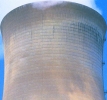

The function of the demineralisation train is to produce high purity make-up water to replace normal system losses and to provide water during start-up. Make-up water is a potential source of contamination and is produced from raw water, which contains high levels of dissolved minerals: sodium, potassium, calcium, magnesium, chloride, carbonate, and sulphate salts, as well as silica. Many of these minerals are corrosive and/or scale forming, which is a threat to plant equipment. Monitoring of these minerals is essential for good plant operation.
A typical demineralisation train converts raw water, containing between 100 and 1500 ppm dissolved solids, into water that contains no more than 10 to 20 ppb dissolved solids. Make-up water treatment may consist of filtration, softening, chlorine removal, reverse osmosis, degasification, and ion exchange. In reverse osmosis (RO), a pump forces water through a semi-permeable membrane, which blocks the passage of dissolved salts and allows relatively ion-free water, permeate, to accumulate on one side of the membrane. An efficient RO system can remove approximately 98% of the dissolved salts and silica in the raw water and nearly all large organic molecules. Contacting conductivity sensors placed in the feed water and permeate let operators monitor the overall water quality and efficiency of the RO system.
Feed water pre-treatment and accurate monitoring is necessary to ensure successful operation of the RO unit. Pre-treatment includes filtration, sodium softening, and chemical treatment. Chemical attack can occur on the cellulose acetate RO membranes when the pH is outside the acidic range. To protect the membrane, the acidity of the feed water is adjusted with the use of a pH measurement. A general-purpose pH sensor such as Rosemount's Model 399 can complete this measurement.
In some applications, it may be necessary to either add chlorine to the water as a biocide, or to remove chlorine from the water with carbon beds to protect the RO membrane from chlorine attack. Carbon beds will saturate after a period of time. Therefore, a chlorine monitor is used to detect breakthrough of chlorine and protect the RO membrane.
RO systems rarely produce water of sufficient purity for direct use as make-up; therefore, the RO permeate is usually polished using an ion exchanger (IX). IX systems come in many configurations, to remove unwanted ions from RO treated water, and consist of a series of tanks containing small beads of synthetic resin. The beads have been treated to selectively absorb either cations or anions.
For example, a two-bed IX has two separate tanks of cation and anion exchange resins. A conductivity measurement is made at the discharge of the anion exchanger to monitor the water purity. An increase in the conductivity signals the end of the bed's efficiency. A cation bed exchanges positively charged ions (such as calcium, magnesium, and sodium) for hydrogen (H+), and the anion bed exchanges negatively-charged ions (such as chloride, sulphate, and bicarbonate) for hydroxyl (OH-). The displaced H+ and OH- combine to form water (H2O). The anion bed also removes silica.
Carbon dioxide is a by-product of cation exchange and of the various acids used to control pH levels in the process water. Degasification systems are used to remove carbon dioxide gas from treated water and will reduce the frequency of regeneration and chemical costs. A degassifier is typically placed between the cation and anion IX beds, or after an RO unit.
Once the IX has exhausted, it is removed from service and regenerated. Regeneration restores the cation exchange beads to the hydrogen form and the anion resin beads to the hydroxide form. Cation resin is regenerated with sulphuric or hydrochloric acid, and anion resin is regenerated with sodium hydroxide. The concentration of acid and sodium hydroxide is monitored continuously by measuring the conductivity of the regenerant as it enters the tanks. During rinse, toroidal conductivity measurements made on the bed effluent provide accurate and continuous status on how thoroughly the regenerants are rinsed.
A two-bed IX can produce a water purity of less than 1 µS/cm, but a mixed bed IX can provide a water purity of less than 0,1 µS/cm. A mixed IX bed polisher consists of both cation and anion resins, in one bed, to remove trace contaminants missed in the first two beds.
Conductivity measurements in high purity water are not simple. Calibration of the sensors is difficult and should be performed by comparing the sensor against a National Institute of Standards and Technology (NIST) traceable calibrated cell of a known cell constant or by calibrating the sensor in a certified solution. However, upon exposure to the atmosphere, high purity conductivity standards and water are easily contaminated by absorption of carbon dioxide from the surrounding air and any residue in the sample container. Extreme care to prevent contamination is required.
Therefore, it is recommended to use cells precalibrated to NIST standards, such as a NIST-traceable portable conductivity validation kit. The portable conductivity validation instrument contains an NIST-traceable, flow-through conductivity cell, which can be connected to the process sample point via tubing, eliminating the effects of the atmosphere and providing a reliable, accurate, and validated measurement.
Most plant operators measure silica in the product water from the demineralisation train to protect against turbine deposits. Silica is weakly held by anion exchange resins; therefore, as the exchanger exhausts, silica appears in the effluent well before the ionic contaminants. Silica is poorly ionised and cannot be detected by measuring conductivity; therefore, continuous wet chemical analysis is recommended.
For more information contact Luculle Stols, Alpret Control Specialists, 011 249 6700, [email protected], www.alpret.co.za
| Tel: | +27 11 249 6700 |
| Email: | [email protected] |
| www: | www.acs-autocon.com |
| Articles: | More information and articles about Automation Control Solutions |

© Technews Publishing (Pty) Ltd | All Rights Reserved